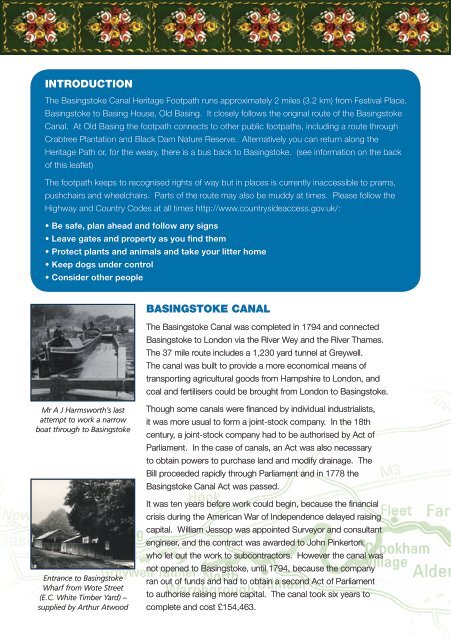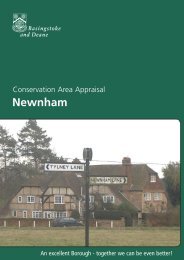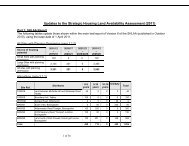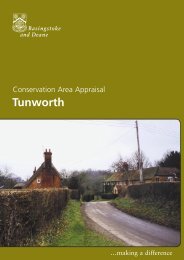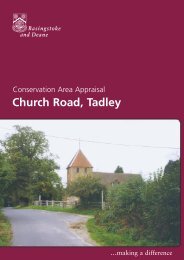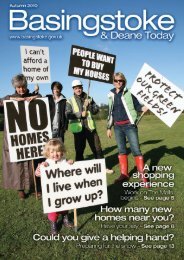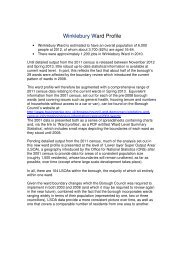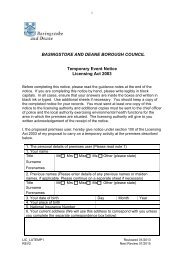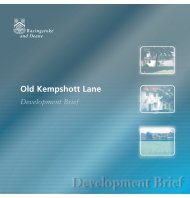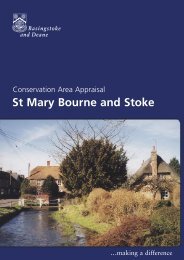Canal Heritage Footpath - Basingstoke and Deane Borough Council
Canal Heritage Footpath - Basingstoke and Deane Borough Council
Canal Heritage Footpath - Basingstoke and Deane Borough Council
You also want an ePaper? Increase the reach of your titles
YUMPU automatically turns print PDFs into web optimized ePapers that Google loves.
Introduction<br />
The <strong>Basingstoke</strong> <strong>Canal</strong> <strong>Heritage</strong> <strong>Footpath</strong> runs approximately 2 miles (3.2 km) from Festival Place,<br />
<strong>Basingstoke</strong> to Basing House, Old Basing. It closely follows the original route of the <strong>Basingstoke</strong><br />
<strong>Canal</strong>. At Old Basing the footpath connects to other public footpaths, including a route through<br />
Crabtree Plantation <strong>and</strong> Black Dam Nature Reserve. Alternatively you can return along the<br />
<strong>Heritage</strong> Path or, for the weary, there is a bus back to <strong>Basingstoke</strong>. (see information on the back<br />
of this leaflet)<br />
The footpath keeps to recognised rights of way but in places is currently inaccessible to prams,<br />
pushchairs <strong>and</strong> wheelchairs. Parts of the route may also be muddy at times. Please follow the<br />
Highway <strong>and</strong> Country Codes at all times http://www.countrysideaccess.gov.uk/:<br />
• Be safe, plan ahead <strong>and</strong> follow any signs<br />
• Leave gates <strong>and</strong> property as you find them<br />
• Protect plants <strong>and</strong> animals <strong>and</strong> take your litter home<br />
• Keep dogs under control<br />
• Consider other people<br />
<strong>Basingstoke</strong> <strong>Canal</strong><br />
The <strong>Basingstoke</strong> <strong>Canal</strong> was completed in 1794 <strong>and</strong> connected<br />
<strong>Basingstoke</strong> to London via the River Wey <strong>and</strong> the River Thames.<br />
The 37 mile route includes a 1,230 yard tunnel at Greywell.<br />
The canal was built to provide a more economical means of<br />
transporting agricultural goods from Hampshire to London, <strong>and</strong><br />
coal <strong>and</strong> fertilisers could be brought from London to <strong>Basingstoke</strong>.<br />
Mr A J Harmsworth’s last<br />
attempt to work a narrow<br />
boat through to <strong>Basingstoke</strong><br />
Entrance to <strong>Basingstoke</strong><br />
Wharf from Wote Street<br />
(E.C. White Timber Yard) –<br />
supplied by Arthur Atwood<br />
Though some canals were financed by individual industrialists,<br />
it was more usual to form a joint-stock company. In the 18th<br />
century, a joint-stock company had to be authorised by Act of<br />
Parliament. In the case of canals, an Act was also necessary<br />
to obtain powers to purchase l<strong>and</strong> <strong>and</strong> modify drainage. The<br />
Bill proceeded rapidly through Parliament <strong>and</strong> in 1778 the<br />
<strong>Basingstoke</strong> <strong>Canal</strong> Act was passed.<br />
It was ten years before work could begin, because the financial<br />
crisis during the American War of Independence delayed raising<br />
capital. William Jessop was appointed Surveyor <strong>and</strong> consultant<br />
engineer, <strong>and</strong> the contract was awarded to John Pinkerton,<br />
who let out the work to subcontractors. However the canal was<br />
not opened to <strong>Basingstoke</strong>, until 1794, because the company<br />
ran out of funds <strong>and</strong> had to obtain a second Act of Parliament<br />
to authorise raising more capital. The canal took six years to<br />
complete <strong>and</strong> cost £154,463.


